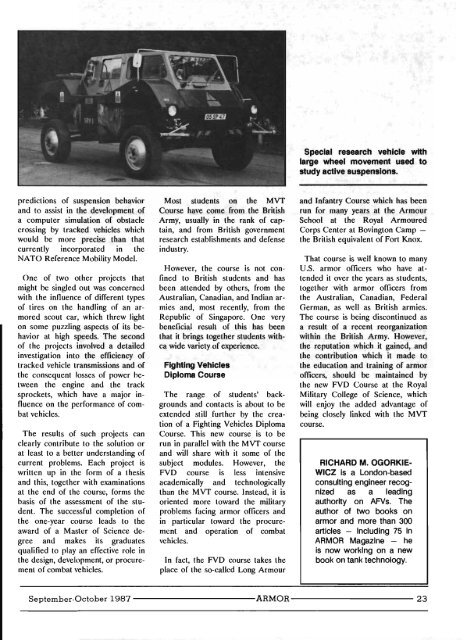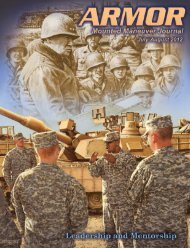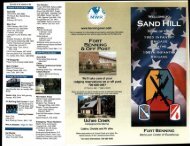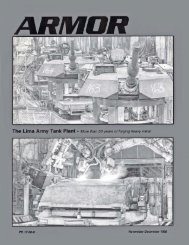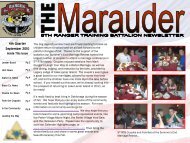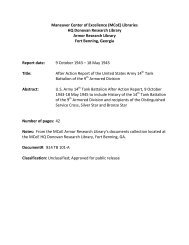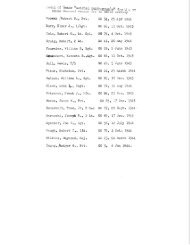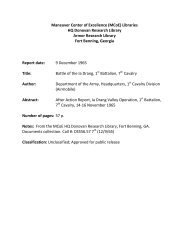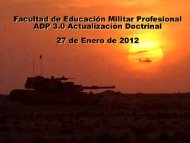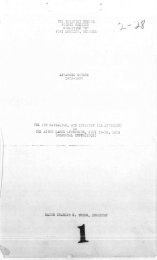ARMOR, September-October 1987 Edition - Fort Benning - U.S. Army
ARMOR, September-October 1987 Edition - Fort Benning - U.S. Army
ARMOR, September-October 1987 Edition - Fort Benning - U.S. Army
Create successful ePaper yourself
Turn your PDF publications into a flip-book with our unique Google optimized e-Paper software.
predictions of suspension behavior<br />
and to assist in the development of<br />
a computer simulation of obstacle<br />
crossing by tracked vehicles which<br />
would be more precise than that<br />
currently incorporated in the<br />
NATO Reference Mobility Model.<br />
One of two other projects that<br />
might be singled out was concerned<br />
with the influence of different types<br />
of tires on the handling of an ar-<br />
mored scout car, which threw light<br />
on some puzzling aspects of its be-<br />
havior at high speeds. The second<br />
of the projects involved a detailed<br />
investigation into the efficiency of<br />
tracked vehicle transmissions and of<br />
the consequent losses of power he-<br />
tween the engine and the track<br />
sprockets, which have a major in-<br />
fluence on the performance of com-<br />
bat vehicles.<br />
The results of such projects can<br />
clearly contrihute to the solution or<br />
at least to a better understanding of<br />
current problems. Each project is<br />
written up in the form of a thesis<br />
and this, toget her with examinations<br />
at the end of the course, forms the<br />
basis of the assessment of the stu-<br />
dent. The successful completion of<br />
the one-year course leads to the<br />
award of a Master of Science de-<br />
gree and makes its graduates<br />
qualified to play an effective role in<br />
the design, development, or procure-<br />
ment of combat vehicles.<br />
Most students on the MVT<br />
Course have come from the British<br />
<strong>Army</strong>, usually in the rank of cap-<br />
tain, and from British government<br />
research establishments and defense<br />
industry.<br />
However, the course is not con-<br />
fined to British students and has<br />
been attended by others, from the<br />
Australian, Canadian, and Indian ar-<br />
mies and, most recently, from the<br />
Republic of Singapore. One very<br />
beneficial result of this has been<br />
that it brings together students with-<br />
ca wide variety of experience.<br />
Fighting Vehicles<br />
Diploma Course<br />
The range of students’ back-<br />
grounds and contacts is about to be<br />
extended still further by the crea-<br />
tion of a Fighting Vehicles Diploma<br />
Course. This new course is to be<br />
run in parallel with the MVT course<br />
and will share with it some of the<br />
subject modules. However, the<br />
FVD course is less intensive<br />
academically and technologically<br />
than the MVT course. Instead, it is<br />
oriented more toward the military<br />
problems facing armor officers and<br />
in particular toward the procure-<br />
ment and operation of combat<br />
vehicles.<br />
In fact, the FVD course takes the<br />
place of the so-called Long Armour<br />
Special research vehicle with<br />
large wheel movement used to<br />
study active suspensions.<br />
and Infantry Course which has been<br />
run for many years at the Armour<br />
School at the Royal Armoured<br />
Corps Center at Bovington Camp -<br />
the British equivalent of <strong>Fort</strong> Knox<br />
That course is well known to many<br />
U.S. armor officers who have at-<br />
tended it over the years as students,<br />
together with armor officers from<br />
the Australian, Canadian, Federal<br />
German, as well as British armies.<br />
The course is being discontinued as<br />
a result of a recent reorganization<br />
within the British <strong>Army</strong>. However,<br />
the reputation which it gained, and<br />
the contribution which it made to<br />
the education and training of armor<br />
officers, should be maintained by<br />
the new FVD Course at the Royal<br />
Military College of Science, which<br />
will enjoy the added advantage of<br />
being closely linked with the MVT<br />
course.<br />
RICHARD M. OGORKIE-<br />
WlCZ is a London-based<br />
consulting engineer recog-<br />
nized as a leading<br />
authority on AFVs. The<br />
author of two books on<br />
armor and more than 300<br />
articles - including 75 in<br />
<strong>ARMOR</strong> Magazine - he<br />
is now working on a new<br />
book on tank technology.<br />
<strong>September</strong>-<strong>October</strong> <strong>1987</strong> <strong>ARMOR</strong> 23


